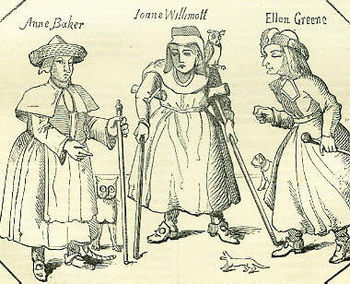- Witches of Belvoir
-
The Witches of Belvoir were three women, a mother and her two daughters, accused of witchcraft in England around 1619. The mother, Joan Flower, died while in prison, and the two daughters, Margaret and Philippa, were hanged at Lincoln.
Account of the accused witches
The story of the Belvoir witches has many classic elements of witchcraft trials. Joan and Margaret had been employed as servants by the Earl and Countess of Rutland, at Belvoir Castle near Grantham, Lincolnshire, but Margaret had been dismissed for stealing. After a series of illnesses and the death of their eldest son Lord Ross or Ros, the Earl and Countess became convinced that the mother and daughters were plotting against them, and at Christmas of 1617 or 1618 they had them arrested. The women were taken to Lincoln gaol where they were examined. Joan Flower would not confess and in an effort to prove her innocence she asked to be brought bread and butter. Before taking a bite she stated that she wished that she should choke on the food if she was not innocent of the crimes of which she stood accused. She is reported to have died after taking her first mouthful of the food.
The two daughters confessed, revealing that they had entered into communion with familiar spirits that had assisted them with their schemes. The mother's familiar was a cat named Rutterkin. The women admitted that they stole the glove of Lord Ross and gave it to their mother, who had dipped it in boiling water, stroked it along Rutterkin's back, and pricked it. Combined with some incantations this supposedly caused Lord Ross to become ill and die. An attempt to harm Lady Katherine, the Earl's daughter, had failed when it was found that Rutterkin had no power over her. The women had also taken some feathers from the quilt of Rutland's bed and a pair of gloves. By boiling these in water mixed with blood they cast spells to prevent the Earl and Countess from having any more children. Both women admitted to experiencing visions of devils and that their familiar spirits visited them and sucked at their bodies.
During the examination, they revealed the names of other women who had aided them, Anne Baker of Bottesford; Joan Willimot of Goodby; and Ellen Greene of Stathern. All three women were taken for examination and revealed that they too had visions and consorted with familiar spirits. Willimott said her familiar was called Pretty and had been blown into her mouth by her former master in the form of a fairy, later reappearing in the form of a woman who asked her to give up her soul. She claimed that she only used the familiar spirit to enquire about the health of people she had attempted to heal. Greene claimed that she had accompanied Willimot into a wood where she said Willimot had conjured up two spirits in the form of a kitten and a "moldewarp" (mole) which had climbed on her shoulders and sucked at her ears. Greene sent these familiars to kill a man and woman with whom she had argued and both died within a fortnight. Baker also confessed to possessing a familiar in the form of a white dog, but most of her testimony concerned the visions she had witnessed.
Margaret and Philippa were hanged in Lincoln castle on 11 March 1618/1619. The Earl and Countess remained so convinced that their son had been killed by the effects of witchcraft that they had it inscribed on their monument at Bottesford church.
References
- W and R Chambers (Eds.) (1869). "Chambers Book of Days — The Witches of Belvoir". http://www.thebookofdays.com/months/march/11.htm. Retrieved 16 January 2007.
- Thomas Wright (1852). Narratives of Sorcery and Magic, from the Most Authentic Sources. Redfield. pp. 420.
There is a very accomplished novel about the Belvoir witches by Hilda Lewis, The Witch and the Priest (1956), of which second hand copies are readily available.
Witch-hunts in Early Modern Europe In British Isles Witches of Warboys (1589–1593) · North Berwick witch trials (1590) · Pendle witches (1612) · Northamptonshire witch trials (1612) · Samlesbury witches (1612) · Witches of Belvoir (1619) · Bury St. Edmunds witch trials (1645, 1662, 1655 & 1694) · Bideford witch trial (1684) · Paisley witches (1696) · Islandmagee witch trial (1711)
In France Aix-en-Provence possessions (1611) · Loudun possessions (1634) · Louviers Possessions (1647) · Poison affair (1679)
In Germany Wiesensteig witch trial (1562–1563) · Trier witch trials (1581–1593) · Fulda witch trials (1603–1606) · Ellwangen witch trial (1611–1618) · Würzburg witch trial (1626–1631) · Bamberg witch trials (1626–1631) · Witch trial of Fuersteneck (1703)
In Scandinavia Køge Huskors (1608–1615) · Finspång witch trial (1617) · Vardø witch trials (1621) · Ramsele witch trial (1634) · Kirkjuból witch trial (1656) · Vardø Witch Trials (1662–1663) · Mora witch trial (1669) · Torsåker witch trials (1675)
Elsewhere
in EuropeValais witch trials (1428–1447) · Val Camonica witch trials (1505, 1518) · Fairy witch trials of Sicily · Benandanti · Basque witch trials (1609) · Roermond witch trial (1613) · Spa witch trial (1616) · Werewolf witch trials · Witch trial of Nogaredo (1646–1647) · Salzburg witch trials (1675–1681) · Northern Moravia witch trials (1678) · Liechtenstein witch trials (1679–1682) · Szeged witch trials (1728–1729) · Doruchowo witch trial (1783)
Texts Formicarius (1475) · Malleus Maleficarum (1486) · Witchcraft Act (England) (1562) · Newes from Scotland (1591) · Daemonolatreiae libri tres (1595) · Daemonologie (1597)
Other Salem witch trials (1692–1693)
Categories:- People executed for witchcraft
- History of Leicestershire
- History of Lincolnshire
- 1619 in law
- 17th century in England
- People executed by burning
- Executed English women
- 1619 in Europe
Wikimedia Foundation. 2010.

